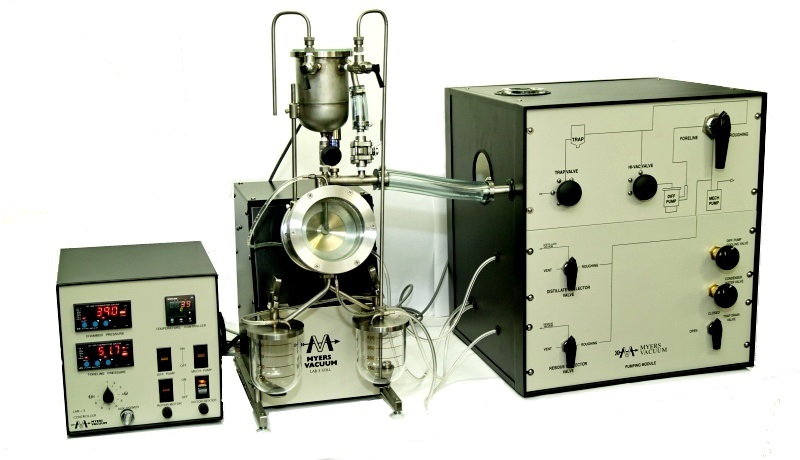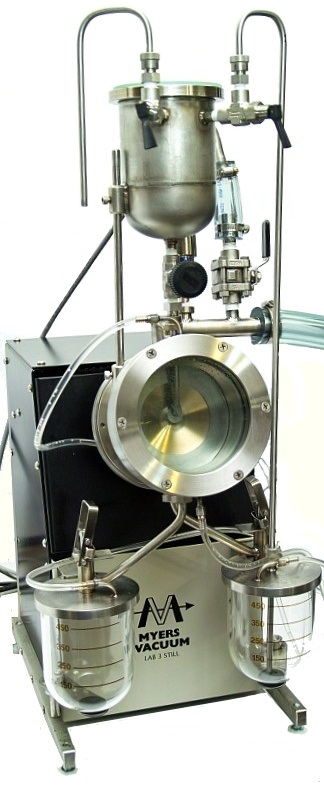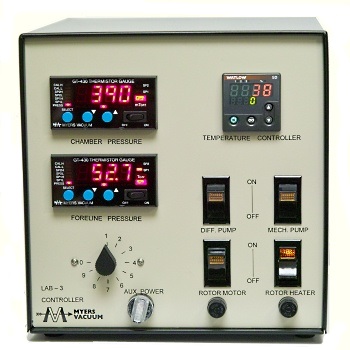 Centrifugal molecular distillation is a purification technique which has gained wide acceptance in the chemical, food processing, pharmaceutical and petroleum industries as well as the specialty chemicals industry.
Centrifugal molecular distillation is a purification technique which has gained wide acceptance in the chemical, food processing, pharmaceutical and petroleum industries as well as the specialty chemicals industry.
The principle behind the Myers Vacuum Centrifugal Molecular Stills is low pressure and extremely short residence time. Once the feed material has been degassed, it flows onto the spinning heated disc. Distillation takes place in less than 1 second as the material expands out exponentially on the radius of the disc. The residue is caught within a gutter surrounding the rotor and then flows down to the collecting vessel below. The distillate condenses on the outer shell of the still and flows by gravity to another collecting vessel also below the still.
The major advantages that can be expected from the Lab-3 Molecular Still are:
- High product percentage yield.
- Close to 1 theoretical plate.
- Elimination of color bodies.
- Elimination of odor fractions.
- Reduction of acid values in ester distillation.
- Removal of excess reactants.
- Elimination of residual metal catalysts.
- Minimized thermal hazard (a necessity for heat sensitive compounds).
- The still itself may be purchased separately or with controls and pumping system.
The Lab-3 has a 3 inch diameter rotor with a throughput capability of about 0 – 2 lbs/hour. Like the other still models, the Lab-3, with the pumping system will operate around 1 micron pressure.

Lab 3 Features
There are several important design features on the Lab-3 that make it an outstanding tool in the laboratory:
- Simple to clean. – Mostly stainless steel so there is little glass to break.
- No gear pump to clean or leak.
- Modular design allows for easy set up and moving location.
- Sits on a lab bench and takes up very little space.
- Sight port lets one see the process occurring.
- Feed material flows from a degasser feed chamber to the still below, where distillation takes place, and then, to collection vessels directly beneath the still. The material flows by gravity in a vertical path, thus preventing holdup anywhere along the way.
- Can easily be heat traced for higher melting point products.
- Information learned on the Lab-3 may be used in scaling up to larger sized equipment.
- May be purchased separately for customers who already have an adequate vacuum system, pressure gauge and temperature control.
- Distills batches as small as 50 ml or up to 2 lbs/hr.
Operating Objectives
The Lab-3 is designed to distill thermally sensitive organic and silicone compounds in the molecular weight range of 150+ AMU at vacuums from 1 to 700 X 10-3 Torr. Some examples of distillation from the Lab-3 include Fatty acid amides, Dimer acids, Epoxy resins, Drying oils, Monesters, Di-octyl phthalate, and Vitamin A Tocopherols (Vitamin E).
 Material Handling
Material Handling
The Lab-3 high vacuum still is designed as a batch / continuous distillation unit. Figure to left illustrates the flow of the process material through the still. Green designates Feed material, Blue Residue and Yellow distillate.
The material flows by gravity from the Degasser reservoir: where the material is also degassed by removing small amounts of low boiling materials and trapped gases to enable more efficient vacuum distillation at the next stage.
The material then flows via the rotor feed valve (17) on to the center of the heated, spinning rotor (5) in the high vacuum distillation chamber. On the rotor, the material spreads out into a thin film (0.05 mm thick).
As the material spreads across the rotor, a certain portion (the distillate) evaporates. The fraction which distills is selected by the operator. Once set, this remains constant until the run is completed or until new conditions are selected.
The distillate vapor condenses on the condenser in the vacuum chamber and is pumped from the system via the distillate collect valve (15) into the distillate collector (14).
The portion which does not distill (the residue) moves off the edge of the rotor to be trapped by the gutter and is pumped from the still via the residue collect valve (16) into the residue collector (13). The residue may be recycled by opening the recycle valve (18).
Depending upon the feedstock material or process requirements, either the distillate or the residue may be your final product. In many cases both may be of value.
Vacuum System
The Lab-3 is designed to distill materials in the pressure range from 1 to 700 X 10-3 Torr.
The lower the distillation pressure, the lower the heat required to effect distillation, the lower the chance of destroying the product and the lower the energy costs of the purification process.
The Lab-3 includes a complete, fully valved vacuum system (See Figure 1 Purple lines). This fully valved system allows the operator to isolate certain parts of the system while making desired adjustments, thus eliminating the need to completely shut the system down.
All manifolds are stainless steel with standard vacuum fittings for easy disassembly/assembly for cleaning.
The mechanical pump is a direct drive rotary vane vacuum pump. It is used as a forepump for the diffusion pump, and to rough pump the degasser, the distillation, the distillate and the residue chambers.
The High Vacuum pump is a rugged 2″ diffusion pump enabling the distillation chamber to operate under high vacuum.
An automatic temperature controller monitors the output water temperature of the diffusion pump and meters the flow of cooling water for maximum pump efficiency and minimal amount of water usage.
The trap valve removes easily condensable-vapors, or low boiling volatiles so as not to contaminate the oils in the mechanical and diffusion pumps and to prevent oil in those pumps from back streaming into the chamber.
Control Center

The Lab-3 control center contains all of the controls and readouts required for operation:
Vacuum Readout: There is a two (2) – station pressure monitoring section with leak detect mode. This enables the operator to get accurate pressure measurements in the distillation chamber and on the foreline. Plus leak detect function simplifies system check out after reassemby.
Temperature Readout: There is an SCR temperature controller which enables the operator to set and control the temperature of the rotor.
The thermocouple is located inside the rotor for true film temperature measurement.
The control center also provides a variable power switch for the addition of heat tapes if desired.
Complete Lab-3 System Standard Bench Model
Part Number: 285352
Still Assembly: Includes degassing feed chamber, 3″ diameter heated rotor, water-cooled condensing surface, feed valve, distillate / residue valves, and distillate / residue collecting vessels. The residue collecting vessel is equipped with a recycle line returning to the degassing chamber for multiple pass operation. The still components are mounted on a stand and are easily accessible for cleaning and maintenance. Wetted components are stainless steel, viton seals and a minimum of glassware.
Pumping System: Includes 2″ diffusion high vacuum pump, mechanical pump, vacuum cold trap, vacuum manifold with valves, and water manifold with valves. It is mounted in a cabinet which connects to the Still Assembly via flexible hoses.
Control Center: Includes thermistor vacuum gauge, digital temperature controller, individual switches for rotation, heater mechanical and diffusion pump, and a variably switched power outlet for the addition of heat tapes.

